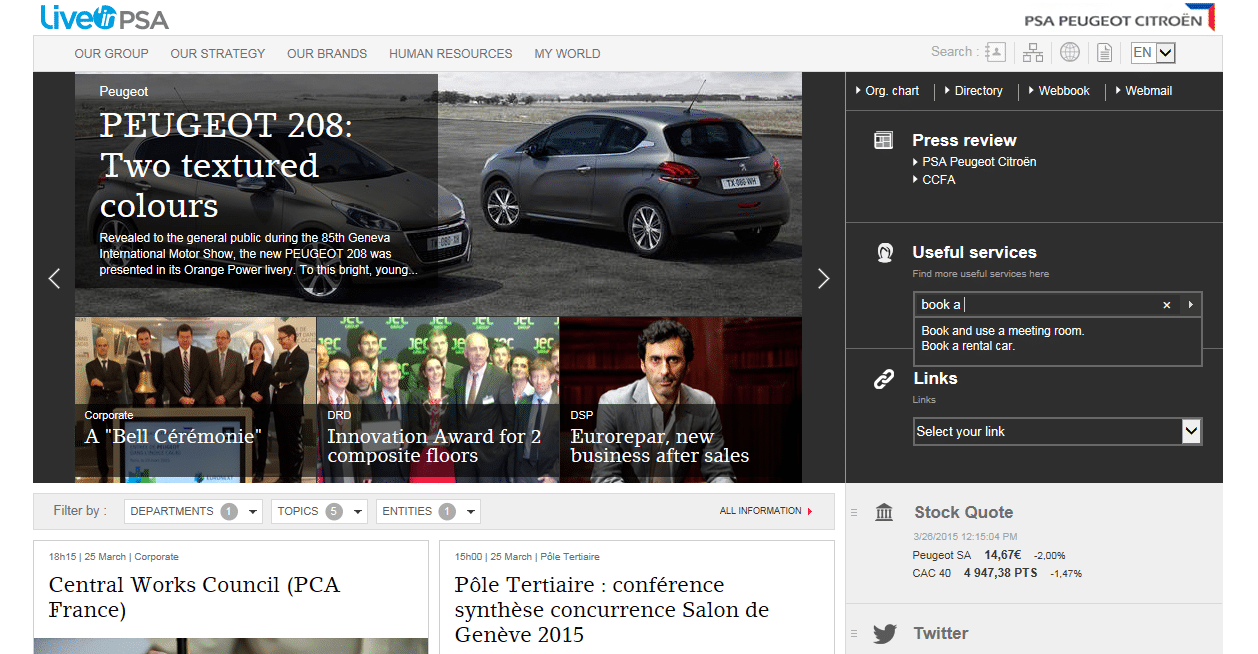PSA Peugeot Citroën promotes self-service for its employees through the use of chatbot with Do You Dream Up.
PSA Digital department has implemented a self-service solution since 2012 in order to respond to internal questions in three domains: helpdesk, HR and practical services.
- Can you please present your company in a few words?
PSA is Europe’s 2nd largest motor manufacturer, established in 160 countries with 184,804 employees. The group’s 2014 turnover was €53.6 billion, with 2,900,000 cars sold. It has also been France’s biggest patent filer for the past 8 years.
- What is your role within your organisation?
We are part of the Digital, Data & Connectivity Engineering department (DDCE), more specifically in an entity in charge of collaborative and Intranet solutions. We coordinate these tools, upgrades and extensions.
- What are your internal challenges in terms of digitisation and your issues?
In December 2011, we initiated a Lean project to reduce helpdesk requests(telephone assistance for all malfunctions relating to the IT environment) and downsize local support teams.
In most cases, the users request these two services although cards (information sheets) are available on the Intranet. The documentation system is therefore not used to its full potential and is difficult to access.
Consequently, one of the primary objectives is to improve user autonomy to reduce the workload of these two support services, with a significant 20% drop in the number of calls.
Required solutions and expertise
- Which solution(s) and expertise did you seek to address these challenges?
As part of this project, one of the options is the implementation of a virtual assistant, designed to provide an answer within 30 seconds and in less than 3 questions. We believe this tool is the equivalent of a smart search engine.
We conducted market research among a number of companies. We chose the Do You Dream Up chatbot after shortlisting two solutions.
- What solution(s) have you implemented with Do You Dream UP? For which types of business process? In which languages?
The 1st version of the Eva chatbot was launched at the end of 2012 to manage employees’ requests in France. The Do You Dream Up project team worked very hard to index all data sheets in the documentary database, in collaboration with the PSA team. This initial phase took three months before production could start.
In 2013, our objective was to improve our responses to employees’ requests. Eva, the virtual assistant, helps identify user needs. This is why we focused our efforts on the most consulted documentation. Therefore we initiated a project designed to improve this content.
The scope was extended in 2014. Eva became multilingual. She is actually trilingual: French, English and Spanish, to reach all employees. In addition, EVA enhanced its content in terms of the company’s human resources and practical services (book a parking space or company vehicle, welcome an external visitor, etc.).
In 2015, Eva became accessible via the Group’s Intranet portal to respond to questions in three domains: helpdesk, HR and practical services.
All these continuous improvements and extensions are made possible by two employees who manage the virtual assistant project.

The results
- How many requests are made via the chatbot? Have you seen an evolution in terms of its adoption by users?
The objective we determined in 2012 was to receive 5,000 virtual agent requests per month.
In 2015, Eva was contacted 140,000 times a month on average. Better yet, the number of requests tripled between January 2015 and January 2016. The consultation of documentation has more than doubled in 3 years. Eva has become a web page traffic controller.
In addition, we have continually enriched the documentary database which currently features 3,000 pieces of information in French, 2,000 in English and 2,000 in Spanish.
- What benefits have you observed?
This chatbot has been favourably received. Eva has become essential to employees, a reflex in fact. We have observed a significant drop in the number of calls to the helpdesk, combined with a constant increase in requests made to the virtual assistant.
Eva has even become a change management driver. It is practical and everybody has access to it.
We can use this channel to anticipate change, which is more readily accepted when it comes from Eva.
The feedback from employee surveys has been very positive.
An increasing number of business domains would like to join the scope of the Eva virtual assistant.
Choice of provider
- Why did PSA choose Do You Dream Up?
The solution proposed by Do You Dream Up helped us control the back office and upgrade the documentation ourselves. This aspect, combined with an efficient reporting system (thanks to the quality of the back office), is why we selected this particular solution.
- How did the Do You Dream Up team support you during this project?
During the start-up phase, the first 1,500 pieces of information were created by Do You Dream Up. Follow-up and corrections are made by the DYDU project manager as she goes along.
The Do You Dream Up project team is very effective and plays a driving role. Bimonthly progress assessments are organised, during which our dedicated project manager introduces new functionalities to be implemented. Scope extensions have rendered the project more complex, which is why assistance from the DYDU project team is vital.
Key success factors
- In your opinion, what are the success factors of this project?
To guarantee the full adoption of this tool, we initially paid particular attention to social issues, with a database of 1,000 pieces of general knowledge which was useful in convincing users. It is also essential to examine the requests on a daily basis in order to understand user needs, notably in the early phases of the project. The examination of negative opinions also helped make the application more reliable and complete.
And in the future…
- What changes do you envisage for these self-service tools? Are you planning to broaden their scope?
In 2016, we are continuing to improve the quality of the responses, but also the content of the documentation. The objective is to get this tool to answer more complex questions (decision tree and problem solving) to further reduce the number of calls to the hotline and even the troubleshooting department.
Interviewed persons
- Fréderic Durka, PSA Group Process architect
- Christine Dokchine, PSA Group IT project manager
- Fabien Sauner, PSA Group IT project manager
Click here to download the pdf version of the interview






